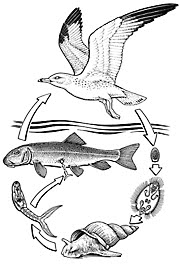Canadian Centre for Biodiversity

Mission
The Canadian Museum of Nature established the Canadian Centre for Biodiversity (CCB) in 1991. Its purpose is to bring together Nature's expertise and experience in systematics research and education to help resolve issues related to biodiversity and conservation, and, in national and international contexts, to act as a central focus for biodiversity information and collaboration efforts.
Method
Changes in biodiversity are key correlates of potential environmental change. The Canadian Centre for Biodiversity provides broad scientific and policy support for relevant investigations in two ways:
- the CCB contributes directly to the coordination and acquisition of knowledge and understanding about biodiversity
- it helps to develop policies and practices for the conservation and wise use of biodiversity in the context of human impact and environmental change. To do so, the CCB plays an essential role in a variety of networks, focusing on biodiversity information, education, training and collaborative efforts.
Diverse Activities
In its role of catalysing and coordinating Canadian research, the CCB hosts the Secretariat of the Biological Survey of Canada (Terrestrial Arthropods). In association with the Entomological Society of Canada, the Survey develops and coordinates national initiatives in systematic and faunistic entomology. Addressing biodiversity and its potential changes, the Survey works with scientists across the country to produce major scientific publications as well as briefs and information documents that are brought to the attention of decision-makers.
We're in This Together
 In its roles toward the development of policies and broader networks, the CCB promotes ongoing liaison and dialogue with government agencies, academics, business leaders, and non-governmental organizations, as well as with members of the public. In its roles toward the development of policies and broader networks, the CCB promotes ongoing liaison and dialogue with government agencies, academics, business leaders, and non-governmental organizations, as well as with members of the public.
 The CCB supports the activities and objectives of the Committee on the Status of Endangered Wildlife in Canada (COSEWIC; the CMN is a founding member of this organization), aided by members of the Life Sciences team who contribute research and prepare and review status reports. The CCB supports the activities and objectives of the Committee on the Status of Endangered Wildlife in Canada (COSEWIC; the CMN is a founding member of this organization), aided by members of the Life Sciences team who contribute research and prepare and review status reports.
 Life Sciences team and Centre members participate in biosystematics research, the NatureWatch programme and other activities within the Ecological Monitoring and Assessment Network (EMAN) and are represented on the EMAN Biodiversity Science Board. Life Sciences team and Centre members participate in biosystematics research, the NatureWatch programme and other activities within the Ecological Monitoring and Assessment Network (EMAN) and are represented on the EMAN Biodiversity Science Board.
 The CCB leads the Working Group on Museums and Sustainable Communities, which enhances the ability of the museum community to share knowledge, build capacity and take actions supporting a culture of sustainability. The CCB leads the Working Group on Museums and Sustainable Communities, which enhances the ability of the museum community to share knowledge, build capacity and take actions supporting a culture of sustainability.
Nature joined the IUCN-The World Conservation Union in 1976 and supports the Union in its mission "to influence, encourage and assist societies throughout the world to conserve the integrity and diversity of nature and to ensure that any use of natural resources is equitable and ecologically sustainable".
 By hosting and coordinating the activities of the Secretariat of the Canadian Committee for IUCN - The World Conservation Union (CC-IUCN), CCB maintains an alliance with government agencies, non-governmental organizations and individuals from across Canada, and linkages with IUCN and its important international conservation network. By hosting and coordinating the activities of the Secretariat of the Canadian Committee for IUCN - The World Conservation Union (CC-IUCN), CCB maintains an alliance with government agencies, non-governmental organizations and individuals from across Canada, and linkages with IUCN and its important international conservation network.
 CCB also hosts the Secretariat of the Medicinal Plant Specialist Group of the IUCN Species Survival Commission. CCB also hosts the Secretariat of the Medicinal Plant Specialist Group of the IUCN Species Survival Commission.
 CCB's collaboration with Université du Québec à Montréal and the Institut de l'énergie et de l'environnement de la Francophonie (a subsidiary body of the Agence de la Francophonie) in the organization of professional training seminars and workshops in developing countries enhances their capacities in natural resources management. CCB's collaboration with Université du Québec à Montréal and the Institut de l'énergie et de l'environnement de la Francophonie (a subsidiary body of the Agence de la Francophonie) in the organization of professional training seminars and workshops in developing countries enhances their capacities in natural resources management.
 CCB's collaboration with a colleague at Université du Québec à Montréal and the Institut de l'énergie et de l'environnement de la Francophonie (a subsidiary body of the Agence de la Francophonie) in the organization of professional training seminars and workshops in developing countries enhances their capacities in natural resources management. CCB's collaboration with a colleague at Université du Québec à Montréal and the Institut de l'énergie et de l'environnement de la Francophonie (a subsidiary body of the Agence de la Francophonie) in the organization of professional training seminars and workshops in developing countries enhances their capacities in natural resources management.
|




 In its roles toward the development of policies and broader networks, the CCB promotes ongoing liaison and dialogue with government agencies, academics, business leaders, and non-governmental organizations, as well as with members of the public.
In its roles toward the development of policies and broader networks, the CCB promotes ongoing liaison and dialogue with government agencies, academics, business leaders, and non-governmental organizations, as well as with members of the public.